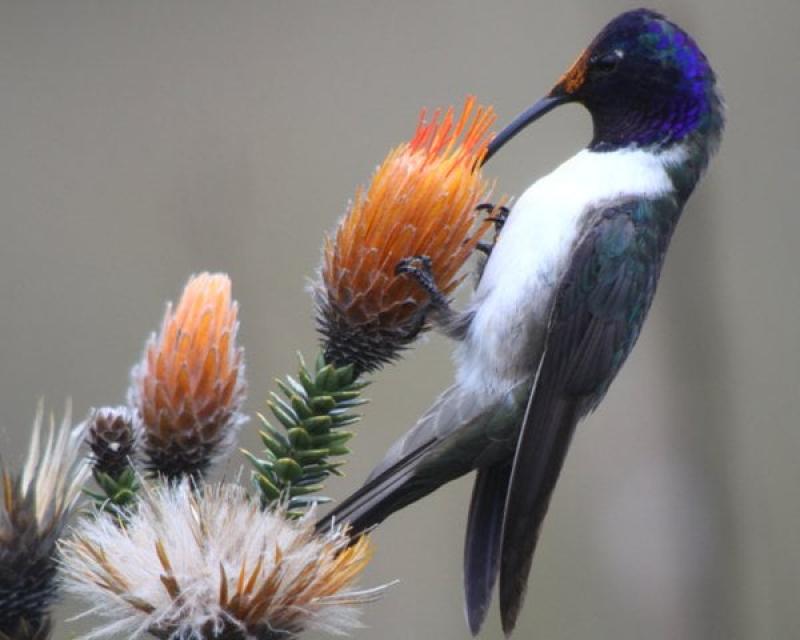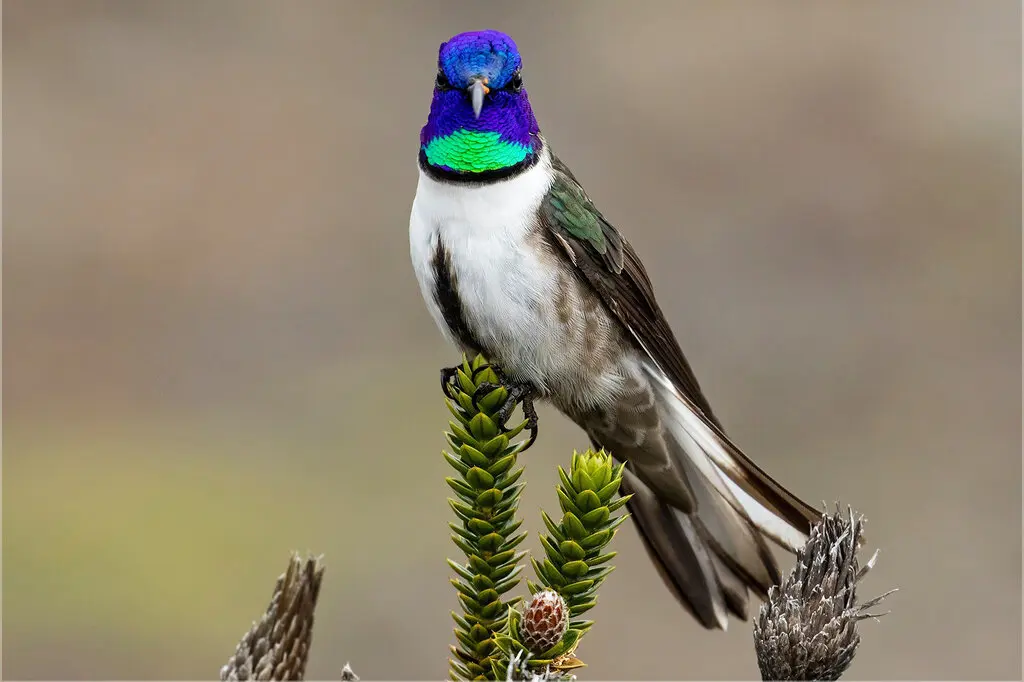Hummingbirds Living in a Hive Found for the First Time


In a remote mountain cave in Ecuador, hummingbirds were discovered sleeping and nesting together.

Amid the MAGA madness, there is news of life.
Hummingbirds are among my favorite things in the whole world!


A male Chimborazo hillstar, a subspecies of high-altitude hummingbird
native to the Andes of Ecuador and far southern Colombia.
Dusan Brinkhuizen
Hummingbirds are tiny and delicate, but don’t be fooled: They are among the most aggressive birds in the avian kingdom. Their territorial fury is especially aimed at other hummingbirds. Competition over a patch of flowers or a mate often results in high-speed aerial chases, divebombing and beak jousting.
So when Gustavo Cañas-Valle, an ornithologist and birding guide, stumbled across a cave full of hummingbirds nesting and roosting together in Ecuador’s High Andes, he could hardly believe it.
“I thought, ‘This looks like a colony,’” Mr. Cañas-Valle said. He added, “They were like bees.”
He documented 23 adult birds and four chicks, all of the subspecies Oreotrochilus chimborazo chimborazo, commonly known as the Chimborazo hillstar.
Mr. Cañas-Valle’s discovery, described in the journal Ornithology in November, may be the first documented example of hummingbirds that nested and roosted communally. It is also notable that he found the birds engaging in both these behaviors in the same space — something that even highly social species from other bird families tend not to do.
Juan Luis Bouzat, an evolutionary geneticist at Bowling Green State University in Ohio and another author of the study who is also Mr. Cañas-Valle’s former graduate adviser, said the finding raised fascinating questions about the role environmental factors can play in driving group living and in promoting the evolution of certain social traits.
Dr. Bouzat and Mr. Cañas-Valle at first hypothesized that harsh environmental conditions along the Chimborazo volcano where they found the nests had forced the birds together. The birds live more than 12,000 feet above sea level on a sparsely vegetated slope where it is hard to come by nectar-providing flowers, water or shelter from freezing temperatures and biting winds.
“Either you aggregate or perish,” Dr. Bouzat said.

A view of a snow-topped mountain with a sparsely vegetated plain in the foreground.
The birds live more than 12,000 feet above sea level on a sparsely vegetated slope
where it is hard to come by nectar-providing flowers,
water or shelter from freezing temperatures and biting winds.
Gustavo Cañas-Valle
But this may not be the full story. Mr. Cañas-Valle explored the region and found six other examples of hummingbirds nesting and roosting together. He and Dr. Bouzat also surveyed concrete drainage pipes scattered around the area. The pipes had similar environmental conditions to the cave but could fit only one or two nests. The researchers found that just 45 percent of the pipes were occupied by nesting females — significantly lower than the frequency expected by chance, according to computer simulations the authors conducted.
There were significantly more nests found in groups, on the other hand, than there would have been if randomly predicted. Of the 74 total nests Mr. Cañas-Valle documented, 82 percent were part of groups. Taken together, these findings implied that the birds were actively choosing group living over nesting alone.
Dr. Bouzat suspects that environmental factors originally caused the birds to aggregate but that once they bunched together, they evolved traits that made them more social, helping them adapt to their environment.
“I was very surprised to read about a truly colonial hummingbird, because most are aggressive and intolerant of others of the same species,” said Scott Robinson, an ornithologist at the Florida Museum of Natural History who was not involved in the work. “No one would have considered a hummingbird a candidate for coloniality.”

A hummingbird nestled on orange-flowering shrubs.
The hummingbird's plumage is a dull gray and orange, faintly mimicking the surrounding flora.
A female Chimborazo hillstar. Researchers have discovered nesting patterns for this hummingbird subspecies that imply its members are actively choosing to live as a group rather than alone.
Gustavo Cañas-Valle
Charles Brown, a behavioral ecologist at the University of Tulsa who also was not involved in the research, said he was not convinced, however, that the hummingbirds observed in the study actually qualified as being colonial.
Animals that live in true colonies often behave in ways that benefit their neighbors, Dr. Brown said, such as working together to find food or detect predators. While it was interesting to find hummingbirds in close quarters, “there was no evidence of any social behavior on the part of the animals nesting in these clusters,” he said.
Mr. Cañas-Valle pointed out, however, that he observed the hummingbirds from the cave departing and returning together, suggesting a cohesive social group. “It’s not that each one is doing their own thing,” Dr. Bouzat said.
But the authors agree that more research is needed. They hope to conduct behavioral studies to determine if the hummingbirds are merely tolerating each other or are actively cooperating.
They would also like to conduct surveys for other hummingbird species in similar High Andes environments to see if they are engaging in group living, too. “I’m sure there are other unknown caves in the mountains where hummingbirds live,” Mr. Cañas-Valle said. “I’m expecting to find other species, for sure.”
Whatever



Iridescence...
A hive of hummingbirds? The correct term is a charm of hummingbirds ... although a karaoke of hummingbirds might work.
Perhaps the environment has forced a development in their time span of existence to require a step towards civilization of their species. I enjoyed watching hummingbirds at my lakeside chalet where I had hung a hummingbird feeder near my hammock (when I wasn't sleeping - LOL)
A true scientist!
I could have been dreaming about hummingbirds.
Yeah. Sure.
We believe you.
Is there any reason why you shouldn't?
Take another look at the picture. Is that guy dreaming about hummingbirds?
Yeah, right!
Ok, if you can determine what I'm NOT dreaming about, what AM I dreaming about?
Hey!
Let's keep it clean!
Oh, come on Bob. That's not where my hand is.
Sly!
LOL. Okay, I'm done.
At the house I grew up at in Douglas, there was a hummingbird nest hanging from a hook on the front porch. I lived in that house from the time I was 5 to the time I left home at 18 to join the Navy. We would spend hours sitting on the porch watching them come and go in the afternoons and early evenings. The same pair used that nest for years at a time then probably their offspring after that. The house is still there and hopefully the nest along with it. I hope so anyway.
I love hummingbirds. I keep about 4 feeders in the yard during the hummer season. They are so fun to watch. They can be vicious to each other
We only have two feeders....
Environmental canaries in the coal mine...
Interesting comment. Why do you say that?
Very cool.
Great article thanks for sharing. I love hummingbirds, they beautiful and graceful creatures. I drive myself crazy trying to photograph them and finally for Christmas I got a bird feeder with a camera that ties to my phone and computer and hopefully this year a lot of bird pictures.
Please share with the rest of us. I'm awful with a camera so I don't even try
Once we are not up to our hips in snow, the weather warms and things turn green again - perhaps then I will get the thing set up and birds will return to the area.
Then if I get anything good I will share
I used to community garden before Covid caught up with me in November, 2020, before shots were available.
My plot contained more annual flowers and perennials than vegetables. I tended toward fragrant plants that would attract hummingbirds, butterflies, and bees, like iris, asters, and especially penstemons. This one year had been dry overall, but my plot was thriving. During one visit, I heard something fly by my head that emitted a buzzing sound. This happened several times. I looked up and saw this hummingbird staring straight at me at eye level about 6 feet away, not moving other than its wings.
I realized that I had invaded its space and food supply, and it was letting me know in no uncertain terms to go away. Very territorial, not sure of the species, but think it was a broad-tailed. They normally are up in the montane forests during this time of their seasonal travels, but Colorado was having a dry summer with a dearth of thunderstorms, resulting in less wildflowers.
Very interesting and completely opposite to what I thought I knew about them, but it does make sense considering the conditions where they live
Wonderful hummingbirds! I used to keep feeders and they would come to me in the garden and hover and chirp if the feeders were empty!